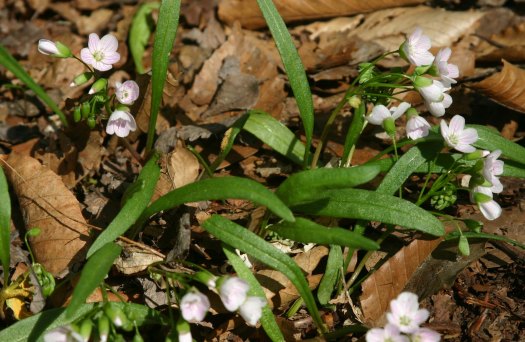Ephemeral (adj.): Lasting for a very short time. This definition clearly describe a group of plants found in wooded areas in early spring, the woodland wildflowers. In this and subsequent articles I’ll introduce you to a number of plants that make an early walk in the woods an experience of discovery. They are wonders of nature, finding their niche in a tough environment and completing their above-ground life cycle during a short window of opportunity in the spring.
One of the first flowers to appear on the floor of the woodland is Spring Beauty, also known as wild potatoes, fairy spuds, or good-morning spring. It is one of the most abundant spring flowers in its range, which extends from Canada through much of the Eastern United States, west to Texas, and includes all of Wisconsin. Its abundance stems from its ability to grow in a wide diversity of sites, from prairies and disturbed areas, to its preferred habitat, a moist woodland. Rarely growing more than 6 inches tall, this member of the Purslane family may cover the forest floor beginning in March and, if the spring is long and cool, extend into May. The botanical name, Claytonia virginica, honors the plant explorer John Clayton (1694-1773) who found it in Virginia in about 1715.
Aptly named, spring beauty can put on quite a show with its clustered flowers reaching above two long, slender, fleshy leaves. The five-petalled flowers may be entirely pink, or white with pink veins. Over 100 species of bees, flies, butterflies, and beetles are attracted to the flowers where they gather pollen and nectar. Adding to its lure are the flower filaments, which reflect ultraviolet light. This light, invisible to humans, can be seen by many bee species.
The flowers of spring beauty open only when the sun is shining, and, like the sunflower, follow the path of the sun. Each flower opens on three consecutive days. On the first day the male reproductive structures, the anthers, ripen and shed their pollen to waiting neighbors. Only on the second and third days, however, is the stigma able to accept pollen, therefore guaranteeing that cross pollination takes place. This is one way that Mother Nature insures the survival of her species, since inbreeding often leads to the decline of a species population.
Spring beauty, like many other woodland ephemerals, completes its entire above-ground life cycle within a few short weeks before the forest trees leaf out. It must flower, set seed, and store up food, all before it goes dormant to await the next spring. Food is stored in an underground modified stem called a corm, which is from 1/2 to 2 inches in diameter and is found 2 to 3 inches under the plant. This corm was prized by Native Americans as a delicate and tasty nut flavored morsel. Cleaned corms are simply boiled for 10 to 15 minutes in salted water, peeled and eaten. Woodland homeowners who find their taste delectable are reminded to eat the large tubers only and replant the others, so as not to deplete the natural supply. As Euell Gibbons states in Stalking the Wild Asparagus, “Let’s not let our greediness for this food destroy or diminish this attractive plant. The tubers are good food for the body, but, after a long winter, the pale-rose flowers in early spring are food for the soul.”
Though spring beauty is one of the first flowers to appear in the spring woodland, it certainly isn’t the only one. Many other ephemerals grace the woodland floor at this time. In future articles, I’ll introduce you to others.

